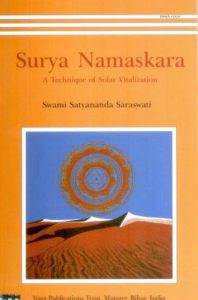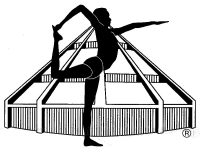Sun Salutation: Surya Namaskara
Sun Salutation: Surya Namaskara











Sun Salutation (surya namaskara in sanskrit) is a flow, combining twelve yoga poses done twice (with each leg). Beginners will perform few rounds, while advanced practitioner will increase the amount when their poses will be enough balanced.
This is a wonderful technique, a full technique of self realization, its base is easy and reachable for anyone. Man can do it slowly the time needed to remember the poses or do it fast while coordinate the breathing on each pose: that becomes then a great cardio exercise!
This article is a small memento for practitioner. There are numerous variations of sun salutations, I’m presenting here the one I’ve been teach (Satyananda school style). I will invite beginners to start with an online course, or – better – with a real teacher! Nothing better than practice, even thousands of readings: you must experiment and feel/ discover what is happening inside your body. There are advanced variations for this technique, we do some of them during the courses, but that’s not the topic of this article.
Last warning: don’t be attached to the name of the poses, I’m not a rigorist, I like it short, and I tell what I’ve learned: for example, parvatasana won’t be called here, neither mountain pose, nor downward facing dog, but pyramid 😉 whatever you call it: this is the same pose!
One Sun Salutation is a workout of doing twice 12 poses, 7 of them are distincts and explained here:
1. Pranamasana
Standing, hands together on prayer pose on the chest, this first posture allows you to center yourself at the start of the practice and to refocus with each sequence.
Beware of your weight balance on your left and right feet. Try to extend your spine as you would like to grow yourself.
Feet parallels wide apart as pelvic bone: they will always return to the same place.
Exhale during this pose.
This is the first as well the last pose of each half-sun-salutation. When you do this sequence several times, you don’t repeat it nor stay longer: the last one is the first one of the next. The breath is fluid, it gives rhythm to the movement, inhale-exhale-inhale-exhale…
2. Hasta Uttanasana

In this backside half-moon, we try to open the chest, and not to excessively arch the lower back.
Grow taller while keeping your fingertips in contact, this allows you to make sure that the extension is well balanced between the right side and the left side.
The face turns towards the sky, without breaking the neck: this movement is accompanied by inspiration.
3. Padahastasana

To take this standing forward bend posture, we will try not to bend the legs or, if flexibility is lacking and it is necessary, the latest as possible: only while placing the hands on the ground.
The hands are placed on either side of the feet: they will not move from this position until you return to this same posture.
On this bending movement, the head and the neck are relaxed in dead weight toward the ground, the belly and the bust press more or less against the thighs and the legs: it is the exhalation that is produced.
4. Ashwa Sanchalanasana

Right foot remains flat on the ground while kicking the toes of the left foot backward, the left knee landing on the ground simultaneously (and vice versa for the second half of the sun salutation). Make sure that the heel does not come off, nor the palms of the hands (or make sure that the two palms of the hands come off as little as possible and in the same way on the right and on the left).
In this equestrian pose, the bust is straightened, the face too, to allow inspiration.
5. Parvatasana

Hands do not move, toes of back foot either, its heel rests (or as much as possible) and the other foot joins it without being in contact (we keep the width of the pelvis between both feet, whether are positioned on the front or on the back), pelvis rises towards the sky, legs are in extension as well as the whole back of the body, the back, the arms.
It is therefore the pyramid 😉 head and neck are relaxed in dead weight toward the ground, lower abdomen is pressed more or less against the thighs: it is exhalation that is produced.
6. Ashtanga Namaskara

The 8-point posture: this posture is barely placed during sequences of the sun salutations when it is punctuated with breath: indeed, on this posture, neither inspiration nor expiration, it is a suspension of the breath, the body grazes the ground to arrive in the following posture.
This pose is nevertheless essential to succeed the sequence: from the posture of the pyramid, it is a question of « diving » forwards by aiming a point between the two hands on the front to put the chin, and at the same time place the chest and knees without placing the belly (that’s it, you have the 8 points, from which the posture takes its name? Chin, chest, hands, knees, toes).
It is not a push-up, but a rotation around the shoulders to push back the ground with the hands and to arrive in the following posture, as if you wanted to pass your head under a horizontal bar posed above your hands … Be careful to push evenly on both arms. (For beginners we can put the knees in a first step before diving forwards, but be careful, this habit is difficult to lose and shifts the overall rhythm!)
7. Bhujangasana

Be careful not to go too far into the arch in this cobra pose, when practicing the sun salutation as a warmup. Take your time: gradually gain amplitude in the movements as the body positions itself.
Keep your toes firmly on the ground: when you link the postures to each other, there must be no parasitic movement: sun salutation is a moving posture and not twelve postures juxtaposed one after the other. It is the rhythmic and balanced breath that makes the link, thanks to the movement of the head.
By pushing back the ground with the arms, we grow taller, we straighten the bust and the face to allow the inspiration.
8. Parvatasana

From the cobra we come back in pyramid: pelvis towards the sky, heels towards the ground with an extension of the back of the body while exhaling.
9. Ashwa Sanchalanasana

Bring back our right foot side to the right hand in its initial position, simultaneously placing left knee on the ground and looking far ahead, keeping both palms of the hands in similar contact with the ground (conversely during second half of sun salutation).
The pelvis is released towards the ground. By standing up to the maximum, we inspire.
10. Padahastasana

Bring back foot parallel to the other one, always respecting the gap of the width of the pelvis. Stretch both legs as well as possible with both hands still on the ground. Bust against our legs, we breathe out.
11. Hasta Uttanasana

Back half moon, as before, inhaling and growing at best, face turned towards fingertips of both hands in contact above the head.
12. Pranamasana

We then return to the starting praying posture, both hands joined in front of the chest while exhaling.
We then continue back half-moon, to start second half of sun salutation with the other leg. Or on a second, third, fourth etc. sun salutation.
Before succeeding breathing properly in this technique, we will take the time to warm up the body, especially if we practice as soon as we wake up (which is of course recommended to derive all the benefits!). It may take 3, 4 or even 8 sun salutations to completely relax the body and be able to follow up on a cardio rhythm. In the same way that a jogger runs in short strides several minutes before setting his « cruising » pace.
Go gradually, it’s a magnificent technique, do not disgust yourself by being violent toward yourself. You don’t run a marathon overnight, it’s the same, you won’t do the 108 Sun Salutations right away, but whatever! From the first, you will soon feel your body awaken and the energy released!
—
Of course, the purpose of this article is not to be exhaustive!
For that I refer you to the excellent work of Swami Satyananada Saraswati founder of Bihar School of Yoga in India :

Rechercher :
Magazine
- Meilleurs vœux pour cette nouvelle année ! 1 janvier 2024
- Sun Salutation: Surya Namaskara 29 juillet 2021
- Confinement saison2 : idées de lectures Yoguiques 8 novembre 2020
- Troisième bougie 7 septembre 2020
- La Salutation au Soleil : Surya Namaskara 31 août 2020
Newsletter



